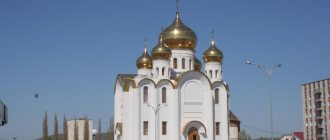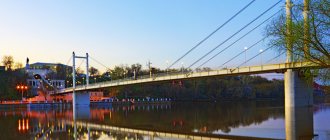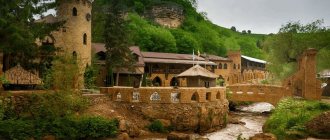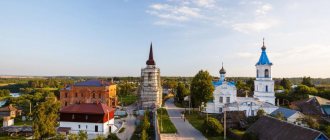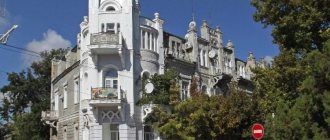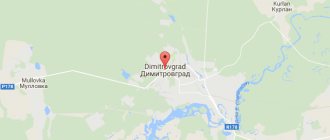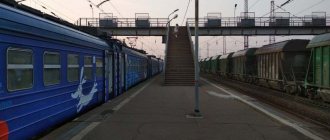The main attractions of the city of Sudogda
A trip to the Sudogodsky district would be incomplete without visiting the Museum of Local Lore and the delightful Khrapovitsky estate. Tourists should also visit the central temple of the city, because its fate reflected many important events from the history of Sudogda.
Estate V.S. Khrapovitsky
- Address: Sudogodsky district, Muromtsevo village, Yamskaya street.
Just three kilometers from Sudogda, in the small village of Muromtsevo, the remains of a magnificent estate have been preserved. In the 19th century, the village belonged to the Khrapovitsky family, descendants of an ancient noble family. The estate was passed down from generation to generation and remained virtually unchanged until it fell into the hands of Colonel Vladimir Khrapovitsky.
In 1884, Vladimir Semyonovich entered into inheritance rights and came to his possessions. The new owner built a delightful palace and park ensemble in the estate in a neo-Gothic style, rare for provincial Russia.
The construction was entrusted to the famous architect Peter Boitsov. The center of the estate was a huge luxurious castle, decorated with towers. A vast park with an arboretum was laid out nearby; dozens of utility and residential buildings and even a small theater were erected on the territory.
After the events of 1917, Khrapovitsky voluntarily transferred his property to the new government and left Muromtsevo. Most of the valuables were transported to the provincial historical museum.
The Forestry College operated in the castle for more than half a century. In the 70s, the administration intended to restore the buildings, but in the end the estate was abandoned. Several fires contributed to the ravages of time. Today the castle is in poor condition and needs urgent restoration, but still attracts tourists.
Museum of Local Lore
- Address: st. Lenina, 65.
The only Sudogda museum was opened in 2007 in the city administration building. The basis of the new museum fund was the collection of the closed museum. Over time, the collection was replenished with new exhibits related to the history of Sudogda and the region.
In addition to the products of the glass factory, at the exhibitions you can see antique furniture, documents, books, photographs and other items. Permanent exhibitions occupy most of the premises; the building also has separate rooms for temporary exhibitions and various cultural events.
Catherine's Cathedral
- Address: st. Lenina, 30.
The main cathedral of the Sudogodsky deanery was erected in 1814. The stone church was built to replace the wooden churches of the Martyr Mina and St. Nicholas of Myra that burned down in 1806. After a terrible fire, the settlement was restored almost from scratch, and the authorities decided this time to build the buildings according to plan. The location for the church was selected taking into account the architectural plan.
The main altar was consecrated in honor of the Great Martyr Catherine. The name of this saint was chosen for a reason: the construction of the cathedral was partly dedicated to the memory of Empress Catherine II, who visited Sudogda in 1767. It was she who transformed the settlement into a city.
The remaining two chapels received the names of the martyr Mina and St. Nicholas in memory of the burned churches. In subsequent years, the temple was reconstructed several times. The huge rebuilt building accommodated 5,000 people; not only the city itself, but also a dozen nearby villages belonged to Catherine’s parish.
After the Revolution, the new authorities repeatedly tried to close the cathedral, but believers defended it each time. In 1937, the church was liquidated into a theater, and 20 years later it was blown up. In the surviving part they opened a House of Culture, a cinema and a shop. In the 90s, the building was returned to believers in poor condition. Currently, the cathedral has been restored, and services are regularly held there.
Khrapovitsky Estate
The palace and park complex is another attraction of Sudogda. The ensemble consists of an eclectic castle, a large number of different buildings and a garden and park area, which were created based on the romantic reverence of the European Middle Ages. The heyday of the estate is associated with the name of Vladimir Semenovich Khrapovitsky. He decided to remodel the estate according to his own tastes and the latest fashion. There is a legend that the castle was built on a bet. During a trip to France, Khrapovitsky made a bet that he would build a castle in Russia that would be in no way inferior to European ones.
Construction of the main palace began in June 1884. The work used bricks from a factory located not far from here, which was also owned by Khrapovitsky. Even now you can see some bricks with the mark “VH”. From 1884 to 1889, horse, carriage and cattle yards, hunting, music and boat pavilions, the Church of the Holy Queen Alexandra, a summer theater, a pier, a manager's house and a water tower were also built.
The main manor house is an asymmetrical architectural composition, which consists of two different buildings. The first is designed in the Romanesque style, in the likeness of French castles of the Renaissance. This is something really worth watching.
Nature of Sudogda and its surroundings
In the vicinity of Sudogda there are rare natural monuments that cannot be found in any other area of the Vladimir region.
Sudogda River
- Coordinates on the map: 55.951895, 40.869713.
The ancient city stands on the left bank of the river of the same name. The Sudogda River is a tributary of the larger Klyazma River. The life of the townspeople has always been inextricably linked with the river; boaters fished on its banks, women washed clothes, and river water was used in farming and when extinguishing fires.
Today, local residents and tourists love to walk along Sudogda, exploring the surrounding area. A round observation deck was built on the shore, fenced with beautiful openwork railings.
Dukinsky quarry
- GPS coordinates: 56.016771, 41.071879.
Near the village of Bolotsky there is an unusual place where both villagers and tourists like to relax. For many years, construction materials were mined here, but at the end of the 20th century, the quarries exhausted their reserves and were abandoned. The rocky terrain contrasts strongly with the typical plains of the region. The bottom of the huge pits is overgrown with forest; in the summer, visitors often set up tent camps here.
The average depth of the quarries is 30 meters; high vertical walls attract climbers from different regions of the country. Beautiful natural sites are part of the reserve of the same name, which was created in 2003. Experts are trying to preserve the rare flora of the protected area and urge numerous tourists not to harm the environment.
Andreevsky quarry
- Address: pos. Tyurmerovka, Sudogodsky district.
Another famous Sudogodsky quarry is located just a few kilometers from the regional center, between the villages of Tyurmerovka and Andreevo. The Andreevsky quarry has existed for more than a hundred years; it began with the plant of Vladimir Khrapovitsky. At the end of the 19th century, Vladimir Semyonovich organized the felling of trees in this area covered with dense forests.
After the Great Patriotic War, a quarry began to be developed in the area where barracks and a sawmill had previously stood. Timber extraction was replaced by the extraction of minerals such as limestone and dolomite flour. A few decades later, the quarry was abandoned, began to be overgrown with pine trees again, and eventually turned into a training base for climbers.
Natural fountain
- Coordinates: 55.959203, 40.959764.
Near Sudogda there is a phenomenon unique to the central zone - a natural fountain, which is sometimes called a geyser. A powerful stream flows from an underground lake on the Peredel River. Jets of water rise vertically to a height of more than three meters. Local residents say that the fountain is weakening every year; 20 years ago it could rise much higher - up to six meters.
In fact, the fountain is not of natural, but of artificial origin. 80 years ago, a geological expedition led by V.V. Belov conducted research in the Vladimir region and drilled several wells, including in the Sudogodsky district. A fountain suddenly appeared from a well near the Peredel River. Scientists left the pipe in the ground, thus creating one of the most beautiful sights of Sudogda.
In 2011, the “geyser” was given the status of a natural monument of Russia. The high-profile title attracted attention to the problems of tourism in this area, and soon the area near the river was transformed: a new road was built to the attraction, the source was lined with stones, and places for recreation and parking appeared.
Tourists come to the fountain all year round; the miracle of nature is impressive in any weather. It looks especially impressive in winter: the water flow turns into a blue block of ice, similar to the throne of the Snow Queen.
Forest trail of K. Thürmer
- Address: Sudogodsky district, Tyurmerovka village.
Karl Thürmer is a personality of enormous magnitude, a brilliant forester who planted several thousand hectares of forest in the Vladimir province. The talented German came to Russia in 1953, at one time he worked near Mozhaisk on the estate of Count Uvarov, then moved at the invitation of Khrapovitsky to Sudogodsky district, where he began planting trees.
Thanks to the unique technology of the craftsmen, his forests looked surprisingly natural for those planted by hand. One of the settlements, Tyurmerovka, was named after the German. Recently, excursions have been held in the area along the so-called “Türmer forest trail”; tourists are shown forest plants and told about healthy berries and medicinal herbs. In 1999, a monument to the great figure was erected in the village.
Sudogodsky Geyser
Sudogodsky geyser is one of my favorite places
Sudogodsky district is famous for its nature. There are wonderful forests and rivers here! One of my favorite places is the Sudogodsky fountain or, as it is more often called, a geyser. This natural monument is located in the bed of the Peredel River. Essentially, it is a spring flowing from an underground lake.
They say the fountain appeared about 100 years ago. Now the height of its jet can reach three meters. Some local residents claim that ten years ago it rose up to five meters!
Sudogodsky Geyser is a popular place. Tourists often come here. This place has become almost a mandatory point for wedding processions. Over time, the area near the source was improved. There is a parking lot, a recreation area, and benches. People come, relax, take pictures and, of course, get water. It's clean, cool and tastes good.
Many people prefer to come here in winter. In cold weather, the geyser becomes overgrown with ice and looks amazing, like a giant stalagmite. On clear days it shines in the sun - a fabulous sight!
The geyser is located not far from Sudogda (about two kilometers) and only 44 kilometers from Vladimir. It will become another point on the weekend trip. If you are going on a trip with the whole family, be sure to stop by here. The children will be delighted!
Interesting places in Sudogda and entertainment
Sudogda cannot offer its guests a variety of entertainment, but this small modest town also has cultural centers, amusement parks and places for walking.
"Glade of Fairy Tales"
- Address: Freedom Square.
Next to the Catherine Cathedral there is a small but beautiful and cozy park. The park was laid out back in Soviet times, but for many years the area was undeveloped, there were rare benches among the trees, and the ground was strewn with garbage.
A few years ago, the area was transformed; paths lined with colorful tiles, comfortable benches, flower beds, a children's playground and many wooden sculptures of fairy-tale characters and funny bear cubs appeared. The park area was named “Glade of Fairy Tales”; now it is a favorite place for city children and their parents.
House of Folk Art
- Address: st. Lenina, 10.
In 1993, one of the first DNT of the Vladimir region was founded in Sudogda. The institution has several folk arts and crafts circles; the center’s specialists try to preserve and popularize ancient Russian customs, costumes and holidays.
The House of Folk Art regularly hosts exhibitions and other events where you can become familiar with the past of the region and the whole country.
The main pride of the masters is the rich collection of ethnic dresses collected from different regions of Russia. Visitors can not only look at works of decorative and applied art, but also make this or that thing with their own hands.
Cultural
- Address: st. Lenina, 44.
Most concerts and creative events in the Sudogodsky district are held in the cultural and leisure center with the patriotic name “Motherland”. The building itself does not have any architectural value; the two-story center was erected during the Soviet era, and is currently in need of renovation.
The main goal of Rodina workers was the cultural education of Sudogod workers and introducing them to the world of art. Employees of modern DNT continue the work of their predecessors. The center regularly hosts competitions, meetings, holidays and even film shows.
Museum of History "Istok"
- Address: Sovetskaya st., 2, Andreevo village.
Not far from Sudogda there is one of the largest villages in the region - Andreevo. The main pride of the settlement is a small library, which is housed in a neat log house with carved frames. Tourists value the rural library not only for its rare century-old copies of ancient books, but also for the tiny “Istok” museum, opened at the institution.
The collection of the local history museum is modest, but interesting; the exhibitions are divided into two sections: the history of the village and the history of the local forestry. The exhibits were collected by the whole world; many villagers donated personal belongings. At the museum you can buy tea bags made from the herbs of St. Andrew's Forest.
The perfect weekend getaway
For a real trip, sometimes one day is enough, because often interesting places are very close. For example, over the weekend you can visit several attractions of the Sudogodsky district. Imagine, about an hour on the road and a wonderful world will open up before you! Larisa Gavrilova, head of the public reception of State Duma deputy G.V., spoke about her favorite “points on the map”. Anikeeva .
What to see in Sudogda from temples
Since ancient times, representatives of different religious denominations lived in Sudogda, but almost all religious buildings belonged to the Orthodox Church. Some ancient temples survived the unrest of the last century, but have survived to this day in a modified form.
Church of St. Alexander Nevsky
- Address: st. Lenina, 54.
The Alexander Nevsky Church was built in 1870 with the money of a local merchant and philanthropist Ivan Bezborodov. A small brick structure in pseudo-Russian style was erected on the territory of the city prison. The Alexander Church was assigned to St. Catherine's Cathedral, so the services were performed by the clergy of the cathedral clergy.
The clergy spiritually cared for not only ordinary parishioners, but also prisoners. A separate entrance was provided for free citizens, while prisoners entered directly from the prison through a special corridor.
After the October Revolution, the Bolsheviks imposed huge taxes on the church community for the use of the temple. The amount turned out to be unaffordable for ordinary believers, and they had to abandon the building. The church was plundered, beheaded and turned into a prison house. Later, a children's technical station was located inside, then the House of Pioneers.
The Agropromenergo office operated in the building for about 25 years. In 1995, the temple was handed over to believers, parishioners immediately began clearing the territory and renovating the premises. During reconstruction, workers discovered ancient frescoes under the paint. The building is still being restored, but the protracted work does not interfere with religious services.
Church of St. mcc. Alexandra
- Address: Sudogodsky district, Muromtsevo village, Pionersky lane.
The colorful tented temple in the village of Muromtsevo is an excellent example of the neo-Russian style in architecture. The delightful stone structure was erected in 1895 at the expense of Vladimir Khrapovitsky, the owner of the estate. Vladimir Semyonovich ordered expensive church utensils from the Faberge factory and everything necessary for interior decoration, including a three-tiered iconostasis. In the summer of 1899, the church was solemnly consecrated in honor of the martyr Queen Alexandra.
After Khrapovitsky transferred the estate to the Bolsheviks, the temple was closed, and all valuables were confiscated in 1922 in favor of the famine-stricken Volga region. At first a club was opened in the building, and later a warehouse. Fuel and lubricants were stored in the room; over 30 years, the walls and floor were saturated with hazardous substances. In 1967, the building was abandoned, and for the next 28 years, the monument of stone architecture deteriorated and collapsed. In 1995, the building was returned to the Church and gradually reconstructed.
Assumption Church
- Address: Mishulina street, village. Moshok, Sudogodsky district.
In the village of Moshok, one of the oldest churches in the Sudogodsky district has been preserved - the Assumption Church, built in 1802. A stone church was erected in place of a wooden one; in the new building there were three altars: the Assumption of the Blessed Virgin Mary, the Apostle John the Theologian and the Kazan Icon of the Mother of God. The parish included surrounding villages with a total population of more than 3,000 people.
The revolution of 1917 brought a lot of grief to the believing villagers. In 1929, security officers arrested the rector Vasily Anisimov, and in 1937 three more priests and two psalm-readers were taken into custody. The church was closed and beheaded, the icons were burned. In 1950, the building housed MTS.
In 1980, the district administration decided to reconstruct the building, but the temple was supposed to serve only as a historical monument. Worship services resumed later, in the 1990s, when the church was handed over to believers. In 2011, a new chapel was consecrated in honor of the locally revered saint, the righteous Savva of Moshok.
Spaso-Preobrazhensky Monastery
- Address: s. Spas-Kupalische, Sudogodsky district.
The Orthodox women's monastery is located in the village of Spas-Kupalische. The spiritual center of the monastery is the ancient Church of the Transfiguration of the Lord, built in 1881. Snow-white walls and bright blue domes attract the attention of tourists and pilgrims from afar. Initially, it was an ordinary parish church; before the construction of a stone building, several wooden structures replaced it.
With the advent of Soviet power, repressions began against the priesthood and ordinary Christians, but the temple continued to operate. After the Great Patriotic War, the church was closed.
The monastic community was formed at the temple relatively recently - in 2001. The nuns restored the architectural monument and developed the area around it. From a small monastery a rather large monastery grew; outbuildings, a cell building and a representative house appeared next to the church. In 2012, the monastery received official status.
Architectural monuments in Sudogda
Numerous fires and other disasters that befell Sudogda in the 19th and 20th centuries could not destroy all the ancient buildings of the city. In the center of the former settlement and in nearby villages, dozens of monuments of civil and residential architecture have been preserved.
Prison Castle
- Address: Maly Krasny Lane.
Walking along one of the central streets of the city, you can notice an old two-story building. Unassuming at first glance, the building has a rich history. Today it is an ordinary residential building, but a hundred years ago its apartments were prison cells, and they were inhabited not by ordinary citizens, but by criminals of various stripes.
The police department, the church of the blessed Prince Alexander Nevsky and all kinds of outbuildings were adjacent to the district prison.
Honorary citizen Ivan Borozdin worked hard for the benefit of the prisoners; the merchant used his own money to build a bathhouse, a hospital and workshops for the prisoners. During Soviet times, the prison was disbanded and rebuilt. Today, families live here and a cultural center operates.
Golubev House
- Address: Lenin street, 47.
The two-story neoclassical mansion on Lenin Street once belonged to wealthy businessman Evgraf Golubev, who founded a local glass factory. The house was built in 1916, but the entrepreneur never really had time to live in it.
A year later, the revolution took place, the policy of dispossession began, and the Golubevs’ possessions were nationalized. During the Soviet years, various institutions were located in the mansion, but recently the building has been empty. The architectural monument is being prepared for restoration, but the expensive work is progressing very slowly.
Fire station
- Address: st. Karl Marx, 57.
In the century before last, the former settlement more than once suffered from large-scale fires, and local rescuers always had a lot of work. The fire service of Sudogda has been located for many years in an architectural monument of the 19th century, which is located in the very center of the city between the Alexander Nevsky Church and the Catherine Cathedral.
The two-story brick building with a wooden tower was built in 1825. Half a century later, the building was reconstructed and has since been repaired many times. The beautiful tower-tower these days no longer fulfills its functions and serves only as a decorative element.
Parish school
- Address: Krasnaya street.
The oldest educational institution in Sudogda was built in 1809, as evidenced by the plaque on the wall of the building. Initially, a parish boys' school operated in a two-story red brick building; by the end of the century, both boys and girls were already studying there.
In the post-revolutionary years, religious education was banned at the school, and the building was used for secular purposes. In 2014, an Orthodox school at St. Catherine’s Cathedral opened in the architectural monument.
Monuments and sculptural compositions of Sudogda
Sudogodsk monuments and memorials remind of heroes and events of the past and unite generations.
WWII Memorial
- Address: Lenin street.
Several decades ago, the townspeople built a large memorial in memory of the Sugodians who did not return from the fronts of the Great Patriotic War. In the middle of the composition there are huge numbers “1941-1945”. The Eternal Flame burns in front of the sculptures all year round.
On both sides of the numbers there are rows of gray slabs, on which are indicated the names of the Sugodians who died during the war. Recently, large color photographs of our fellow countrymen were installed nearby. On Victory Day, as well as on the Day of Remembrance and Sorrow, local residents lay wreaths and bouquets of fresh flowers at the memorial.
Monument to Children of War
- Address: Lenin street.
The most touching and mournful monument in the Sudogodsky district is dedicated to children born before the war and during the war years. The monument is a black slab depicting a girl and a boy.
The children seem to be on fire, the older sister holds her frightened brother close to her with one hand, and covers her face with the other, as if trying to protect herself from the impending danger.
Next to the kids is the inscription “Generation 1928-1945.” The idea of the monument belonged to the Sugod residents, who themselves were children at that terrible time and saw with their own eyes the horrors of the Great Patriotic War. The grand opening of the monument took place in 2005.
Monument to sailors
- Address: Lenin street.
In 2022, a new monument appeared in Sudogda. The monument, made of white marble, is dedicated to all military personnel who are in one way or another connected with the sea: military sailors, naval aviation, marines and border guards. The idea to honor the memory of Soviet and Russian heroes belonged to the Sudogodsky Union of Sailors. The opening of the memorial sign was timed to coincide with the 320th anniversary of the Russian fleet.
Girl with a calf
- Address: Park Polyana Skazok.
An interesting sculptural composition is located on the territory of the Glade of Fairy Tales. The figure of a young calf girl was installed in these places under Soviet rule. The plaster beauty is dressed in a simple dress, her hair is tied up under a headscarf, and her feet are bare. With one hand the worker holds the hem of her dress, with the other she holds the calf clinging to her leg. The girl symbolizes agriculture and the work of ordinary Soviet peasants.
Monument to V.I. Lenin
- Address: st. Lenina, 54.
Several monuments to Vladimir Lenin have been preserved in Sudogda, the most famous of which is installed in front of the central entrance to the former prison castle. The monument looks very distinctive: a small bronze bust of Lenin is barely visible on top of a large pedestal made of gray concrete slabs. On one side of the monument there is a hammer and sickle depicted.
Do not miss descriptions and photos of attractions in other cities of the Vladimir region:
- Vladimir, Bogolyubovo, Murom,
- Suzdal, Kirzhach, Petushkov, Alexandrov,
- Kidekshi, Vyaznikov and Yuryev-Polsky
Sudogda may not be as attractive to tourists as more developed and popular centers, but this provincial town has some inexplicable charm. It’s as if different eras came together in it, and each of them left its own unique mark on its land. Wonderful historical monuments have become commonplace for local residents, but continue to amaze guests of Sudogda.
